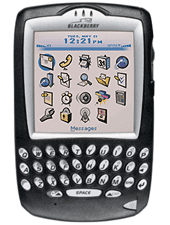 on Blackberry users getting tendinitis from too much thumb-typing.
on Blackberry users getting tendinitis from too much thumb-typing.I've never liked Blackberries because I always thought the keys were too small even compared to my trusty HP 200LX which has keys roughly about 1 x 0.5 mm. I figured out a way to type on them using four fingers on each hand to avoid thumb-typing which I found to be slower and unergonomic. Eventually, I managed to get to about 50wpm on my keyboard with no real tendon stress.Bette R. Keltner, dean of the Georgetown University School of Nursing & Health Studies, has been forced to put her BlackBerry down. After two years of constant use, her hands were in so much pain, she had to stop typing. She remembers the trigger point: It was a 10-hour conference one Saturday where she answered about 150 e-mails. "Days later, I was in excruciating pain," she said.
The American Society of Hand Therapists issued a consumer alert in January saying that handheld electronics are causing an increasing amount of carpal tunnel syndrome and tendinitis. With that warning, the society included directions on how to properly hold the devices, urging users to take breaks and, if possible, place pillows in their laps so their wrists are in a more upright position.
But at airports and hearing rooms and other places where handheld users while away pauses by thumbing their keyboards, there are no pillows in evidence and very few breaks from the tap-tap-click of e-mailing.
I take issue with this line from the article:
Also, though many handheld game devices also use thumb-operated controls, they typically don't require as much range of motion as keyboards spanning the entire alphabet as well as punctuation marks.In my experience, the Playstation2 controller is far more unergonomic than any handheld computer keyboard. The stress its directional pad put on my left thumb was so bad, I almost never use it.
Incidentally, the HP 100/200LX palmtops had text-messaging on them almost a decade before it became cool. In 1994, HP debuted its StarLink service which offered two-way paging and email.